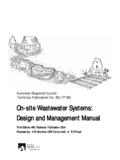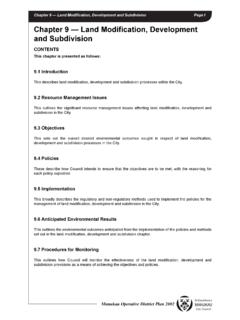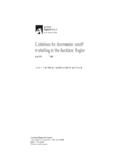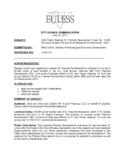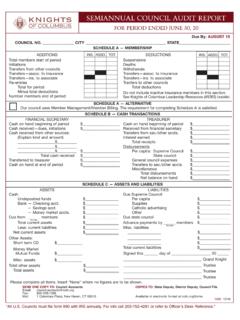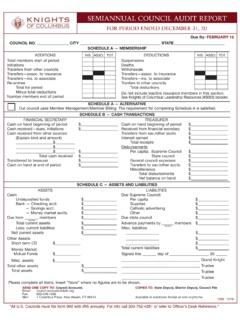Transcription of PART 12 - TRANSPORTATION - Auckland Council
1 part 12 - TRANSPORTATIONCITY OF Auckland - DISTRICT PLANISTHMUS SECTION - OPERATIVE 1999 Page A1updated 04/10/2011 See key on page 1 of this section CONTENT AND RESOURCE MANAGEMENT ISSUES .. RESOURCE MANAGEMENT OBJECTIVES AND POLICIES .. RESOURCE MANAGEMENT STRATEGY .. OTHER SYSTEMS .. ROADING .. PARKING .. RULES : DEVELOPMENT CONTROLS .. TRANSPORTATION ACTIVITIES .. B7 part 12 - TRANSPORTATIONPlan change annotations - keyIndicates where content is affected by proposed plan modification x. Refer to plan modification folder or website for where the content is part of plan modification x, which is subject to content to be through content to be xNote re Page NumberingFor the purpose of page numbering this part has been divided into subsections. This assists with the production of updated sections of the Plan for subscribers. It is also in keeping with the format of the on-line version of the numbering is sequenced as follows:Page A1, A2, A3 etcPage B1, B2, B3 etcPART 12 - TRANSPORTATIONCITY OF Auckland - DISTRICT PLANPage A2 ISTHMUS SECTION - OPERATIVE 1999updated 04/10/2011 See key on page 1 of this sectionPART 12 - TRANSPORTATIONCITY OF Auckland - DISTRICT PLANISTHMUS SECTION - OPERATIVE 1999 Page A3updated 04/10/2011 See key on page 1 of this section TRANSPORTATION in terms of its physical components and their conduct is regarded as a major feature in the urban environment.
2 The use and development of the components of the feature (roading network, motorways, rail lines, port facilities, passenger and pedestrian facilities) must be managed in a manner which contributes to the sustainability of the natural and physical resources concerned and at the same time, avoids or mitigates undesirable effects on the city 's transport system must cater for movement into and across the city from other parts of the region, as well as movement entirely within it. The city is located at the centre of the region and is a net provider of jobs to the other parts of the region. This results in a relatively large inflow of people and vehicles into the city during weekday morning peak periods. The topography results in the concentration of such movements into a small number of transport of an extensive motorway network over the last 30 years has accommodated much of the traffic growth in the main transport corridors.
3 This era is, however, coming to an end. It is unlikely that there will be any new additional motorways to those already built or planned for in the District Plan. Peak period traffic congestion has been increasing rapidly. The ability of critical sections of motorway to cater for higher traffic flows is limited. The city 's arterial road network will, therefore, need to carry a steadily increasing proportion of peak work related traffic in the congested main corridors. This particularly applies to commuter travel to the Central Area if relative accessibility is to be maintained despite increasing congestion on the road part is presented as follow - Resource Management IssuesThis outlines the principal TRANSPORTATION issues and sets out the scope of the TRANSPORTATION question addressed in the Plan. It acknowledges the different levels of resource conservation concerned, from global to local but recognises that the extent of the Plan's direct influence is limited to local urban circumstances.
4 Resource Management Objectives and PoliciesThis outlines how the Plan intends to deal with the particular issues for TRANSPORTATION . Resource Management StrategyThis outlines the strategy for managing the TRANSPORTATION resource and explains the reasons for this approach. ImplementationThis outlines the different methods adopted to meet the objectives and policies of this part . It divides the methods into discussions on Roading, Parking and TRANSPORTATION Activities. RulesThis specifies the range of development controls which the Plan adopts to ensure that the actual or potential effects of the use of the TRANSPORTATION resource do not adversely effect the promotion of the sustainable management of the TRANSPORTATION resource raises issues which range from global to local concerns. The limitations of the Plan's powers and the geographical constraints it operates under, preclude all but local urban issues from its control.
5 However it is important to recognise that local TRANSPORTATION resource issues have a place within the wider context of global, national and regional concerns. Measures taken to promote sustainable management of the resource at a local level, will need to acknowledge and support where possible these wider there is concern over the increasing utilisation of non-renewable fossil fuels by all forms of TRANSPORTATION and the consequent impact not only on future sources of these fuels, but also on the earth's atmosphere in terms of pollution and the greenhouse effect. The issues arising from this concern refer to the need to encourage an efficient use of the energy resource associated with TRANSPORTATION . This is probably best achieved through promoting and supporting the efficient utilisation of existing TRANSPORTATION structures, in particular an efficient public transport system, while ensuring that the effect on the environment at a global, national, regional and local level is avoided, reduced or 12 - CONTENT AND MANAGEMENT 12 - TRANSPORTATIONCITY OF Auckland - DISTRICT PLANPage A4 ISTHMUS SECTION - OPERATIVE 1999updated 04/10/2011 See key on page 1 of this sectionAt a national level, issues such as how to encourage the efficient use of the energy resource and how to achieve more environmentally acceptable TRANSPORTATION systems need to be a regional level TRANSPORTATION issues focus on matters such as how to support and promote an efficient mass public transport system, how to ensure the concentration of the urban area rather than its expansion.
6 And how to maintain and promote efficient and accessible linkages between areas of the region. Locally, TRANSPORTATION issues become more focussed. While the efficient use of the energy resource is still a prime consideration, of specific concern is how to achieve the most efficient sustainable use of the existing TRANSPORTATION infrastructure and how to avoid, mitigate or reduce the effects the use of the TRANSPORTATION resource, has on the local environmentThe Auckland Regional Land Transport Strategy (RLTS) was adopted by the Auckland Regional Land Transport Committee, a standing committee of the Auckland Regional Council , in 1999. The ARLTS seeks a balanced approach to addressing TRANSPORTATION issues. It contains objectives and policies that are to be implemented generally across the region in conjunction with policies and projects related to the specific needs of particular areas. The Passenger Transport Action Plan (PTAP) is a supporting document to the ARLTS.
7 It was created as a result of submissions to the ARLTS and has also been adopted by the Auckland Regional Land Transport Committee. The PTAP summarises the public transport actions outlined in detail in the ARLTS and puts forward a view of the future of Auckland s public transport. Concurrently with these two documents, Auckland city in 1998 adopted the Central Isthmus Strategy (CIS). While the RLTS, PTAP and CIS recognise that there are no simple solutions to the TRANSPORTATION issues of the region, they provide for a range of complementary initiatives as a means to pursue a balanced approach that will keep Auckland terms of the district, TRANSPORTATION is an important and valuable resource. Significant investment has been made in its physical infrastructure and facilities. TRANSPORTATION serves an important link between the Isthmus and other parts of the district and the region.
8 It provides interconnections between activities and communities, and its various forms provide for a variety of changing needs and demands. TRANSPORTATION has had, and will continue to have, a fundamental influence on the urban form and character of the district and on its the current climate of rising car usage and increasing traffic congestion, coupled with an increasing awareness of people's responsibilities to the local and global environment, the need for the sustainable management of the district's TRANSPORTATION system is of immediate concern. A major resource management issue facing the district therefore, is the production of a TRANSPORTATION strategy which recognises the need to provide access, and the safe and efficient movement of vehicles and people, in a way that minimises the adverse effect on the environment of the district and which does not compromise the needs of future the built environment of the city , sustainable management, in the context of TRANSPORTATION , must concentrate on two important issues: how to achieve the safe and efficient use of the existing infrastructure; how to avoid, reduce or mitigate any adverse impact any form of transport may have on the environment and the district.
9 How to provide safely and efficiently for additional transport needs resulting from increased population and employment, intensification of land uses, and economic in these matters is the need for energy efficiency which at a local level can be promoted through provisions which: support increased public transport patronage; encourage a reduction in travel distances or a reduced need for the use of cars for travel between activities; encourage the concentration of the urban environment rather than its expansion. support the reduction of congestion and travel times by improvements to the roading network, where appropriate, which achieve operational efficiencies, greater traffic safety and minimise the adverse effects of vehicle use in the EfficiencyPromotion of sustainable management of the Isthmus TRANSPORTATION resource should aim at the efficient use of the existing TRANSPORTATION infrastructure.
10 This will contribute significantly towards energy efficiency. Fragmentation of the financial and physical responsibility for TRANSPORTATION , to a large extent reduces the likelihood of new TRANSPORTATION facilities and infrastructure. The very nature of new infrastructure often causes unacceptable disruption to existing communities and habitats. There exist various ways by which an efficient use of the resource can be achieved: by ensuring the optimum use of existing facilities through the use of any under utilised capacity which may exist, eg widening of existing roads to their full legal width and the adoption of management techniques; TRANSPORTATION ISSUESPART 12 - TRANSPORTATIONCITY OF Auckland - DISTRICT PLANISTHMUS SECTION - OPERATIVE 1999 Page A5updated 04/10/2011 See key on page 1 of this section by encouraging over time, mechanisms and practices which promote the energy efficient use of private vehicles.

